Top 10 RFP Tools for Enterprises - Who Uses Real AI in 2025?
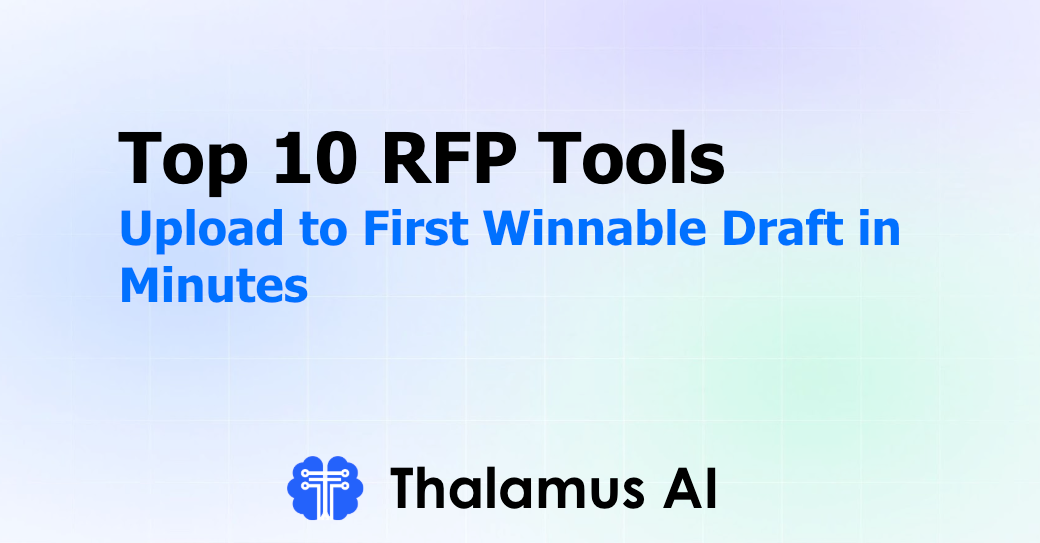
Imagine going from RFx upload to first winnable draft in under 5 minutes. That’s the Thalamus promise. Schedule a live demo to see it firsthand, or visit the website to learn more.
What Are RFP Response Tools and Why Traditional SaaS Platforms Are No Longer Enough
RFP response tools are specialized business software solutions that help enterprises manage the complex, high-stakes process of responding to Requests for Proposals (RFPs), Security Questionnaires, Due Diligence Forms, and other complex response requests. These platforms are built to streamline the end to end proposal process, from document intake to final submission, by automating manual tasks, reducing proposal cycle times, and enabling real-time collaboration between proposal professionals, subject matter experts, and sales teams.
Traditionally, proposal and revenue teams spent hundreds of hours handling repetitive requests - rewriting the same answers, formatting each document manually, and checking compliance line-by-line. Modern RFP response teams eliminate this burden by using automation software and AI-powered features to draft consistent, compliant proposals at scale. The result is faster turnaround times, fewer errors, and higher-quality responses that match each client's expectations, while freeing up teams to focus on personalized pitches, competitive advantage, and data-driven decisions.
Over 65% of teams now use RFP/proposal management software - up from just 48% last year. Users report improved content storage (51%), time savings (50%), higher win rates (+11%), and faster sales cycles (+7%)
Source: Loopio 2024 RFP Trends Report, 2025
The Problem? Static RFP Tools Can’t Keep Up with Today’s Proposal Complexity
Modern RFPs aren’t just checklists. They’re high-stakes evaluations that demand strategic thinking and precision. Here's what today's proposal professionals are up against:
- Analyze Past Wins and Losses, or Fall Behind: Proposal teams need insights into previous outcomes - what worked, what didn’t, to drive smarter, data-driven bid decisions.
- Tailored, Winnable Responses, Not Generic Responses: Every RFP demands nuanced responses across security, legal, product, and compliance domains. Reused content won’t cut it anymore.
- Zero-Margin Turnarounds: Tight submission deadlines leave no room for errors, rework, or back-and-forth. The pressure to deliver high-quality proposals in record time is real.
- Real-Time, Cross-Functional Collaboration: Proposal creation now involves multiple business units - sales, product, legal, IT - often spread across time zones. Seamless collaboration isn’t a nice-to-have; it’s essential.
- Answers That Feel Human: Enterprises expect personalized, technically accurate responses that reflect brand voice and speak directly to the evaluator’s concerns - not AI-sounding boilerplate.
Legacy SaaS platforms were never designed for the complexity of today’s proposal management workflows. They store static content but don’t understand the nuances of Requests for Proposals (RFPs). They organize sales documents and content libraries, but can’t generate accurate answers or provide context-aware responses. They offer basic automation tools like formatting, but fail to assist proposal teams, procurement professionals, and subject matter experts in producing compliant, error-free proposals that actually win deals.
According to OpenAsset’s breakdown of Loopio data, the average RFP win rate has stabilized at 44%, down from 53% in 2019 but consistent through 2021–2023.
Source: OpenAsset, 2024
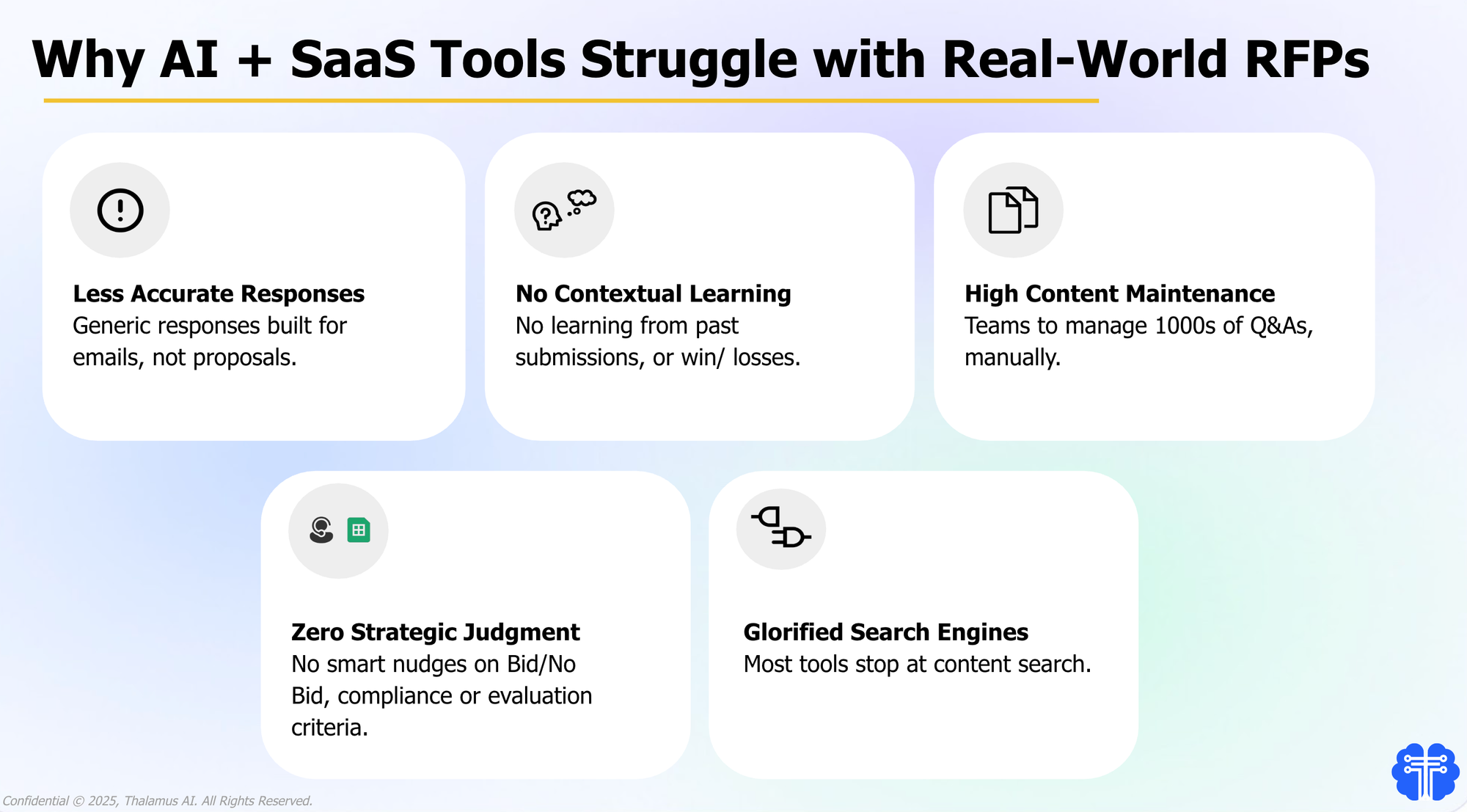
Enter Thalamus AI - Agentic AI RFP Response Tool
Platforms like Thalamus AI are redefining the category by introducing Agentic AI - a network of specialized AI agents that collaborate with humans to handle every stage of the RFP response process. Instead of acting as a static library or glorified document manager, Thalamus:
- Shreds the uploaded RFPs and tags every statement of work, evaluation criteria and instruction.
- Auto-generates the first winnable draft using enterprise-trained content and prompts
- Routes tasks by section/subsection to subject matter experts with contextual handover
- Learns over time from past responses, reviewer feedback, and win/loss outcomes
The result? A complete shift from manual response software to outcome-driven automation - enabling teams to go from RFx Upload to First Winnable Draft in under 5 minutes.
But Agentic AI is only part of the story. What makes Thalamus AI a complete enterprise-grade platform is how it pairs intelligent automation with robust infrastructure designed for scale, compliance, and seamless collaboration.
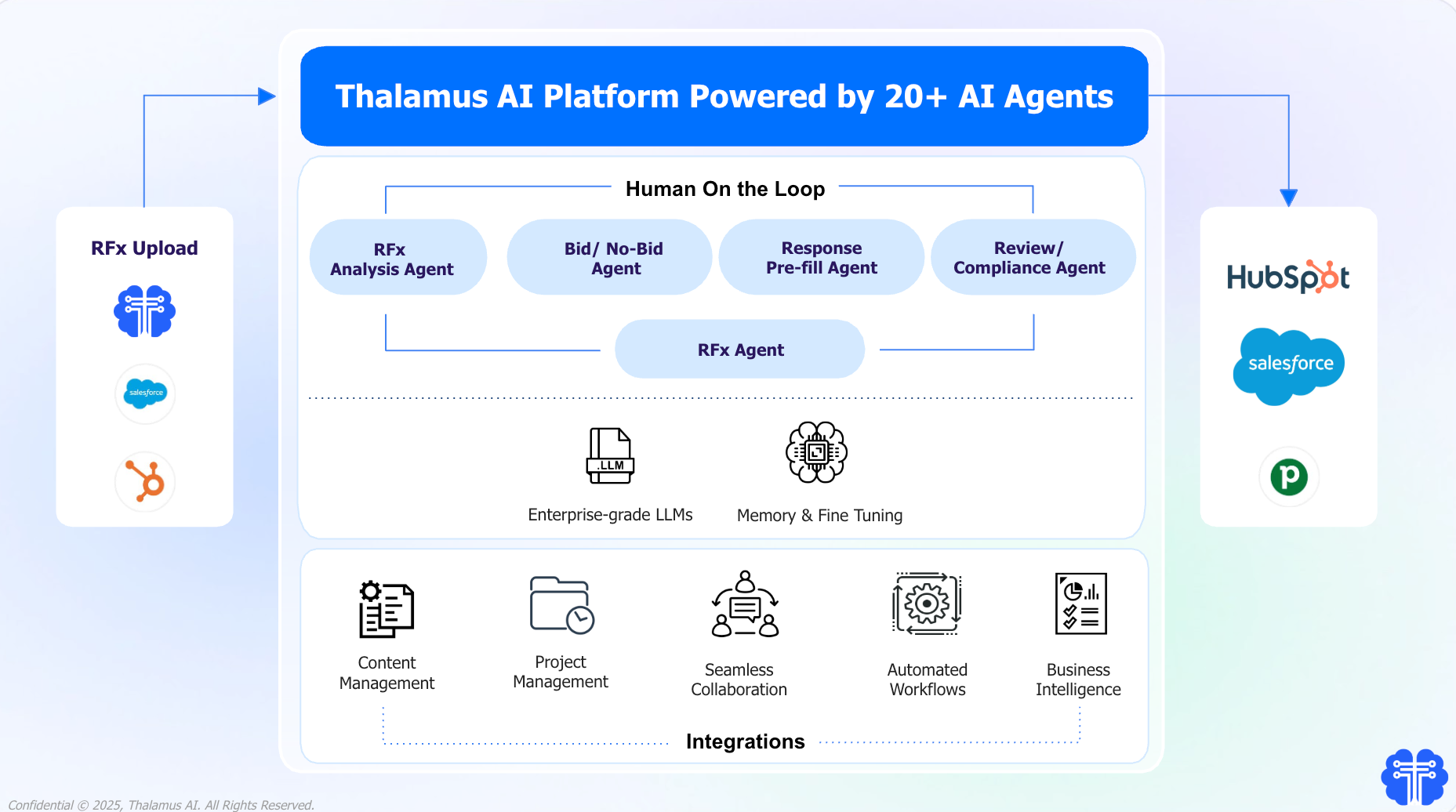
More Than Just AI Agents - A Fully Integrated RFP Operating System
Beyond intelligent agents, Thalamus delivers essential platform capabilities that power the entire proposal lifecycle:
- Centralized Content Management:
Thalamus comes with a dynamic content library that evolves with usage. No more stale, static Q&A templates - responses are version-controlled, tagged by product/compliance themes, and updated through agent-assisted content governance. Read more at: RFP Content Library Chaos? How Agentic AI Brings Order to Madness - Seamless Integrations:
Native integrations with tools like Google Drive, SharePoint, Slack, Salesforce, and Microsoft Teams ensure your team can connect documents, data, and conversations without switching tabs. Everything flows into one workspace. - Project-Based Workflows:
From intake to submission, each proposal runs on a structured, trackable workflow. Tasks are auto-assigned to subject matter experts (SMEs), reviewers, or legal approvers with intelligent routing based on section, role, or prior activity. - Real-Time Collaboration & Review:
Collaborate across global teams with Slack-style comments, in-line suggestions, and live editing. Whether you're reviewing a security questionnaire or finalizing a fee proposal, Thalamus makes asynchronous teamwork feel synchronous. - Automated Workflows & Approvals:
Customize workflows for your enterprise's review process. Trigger legal review, security sign-off, or pricing validation automatically, saving days of back-and-forth and reducing manual handoffs. - Built-In Business Intelligence:
Get real-time visibility into proposal performance, team velocity, win/loss insights, and response usage. Make data-driven decisions on whether to bid, which content performs best, and where process bottlenecks exist.
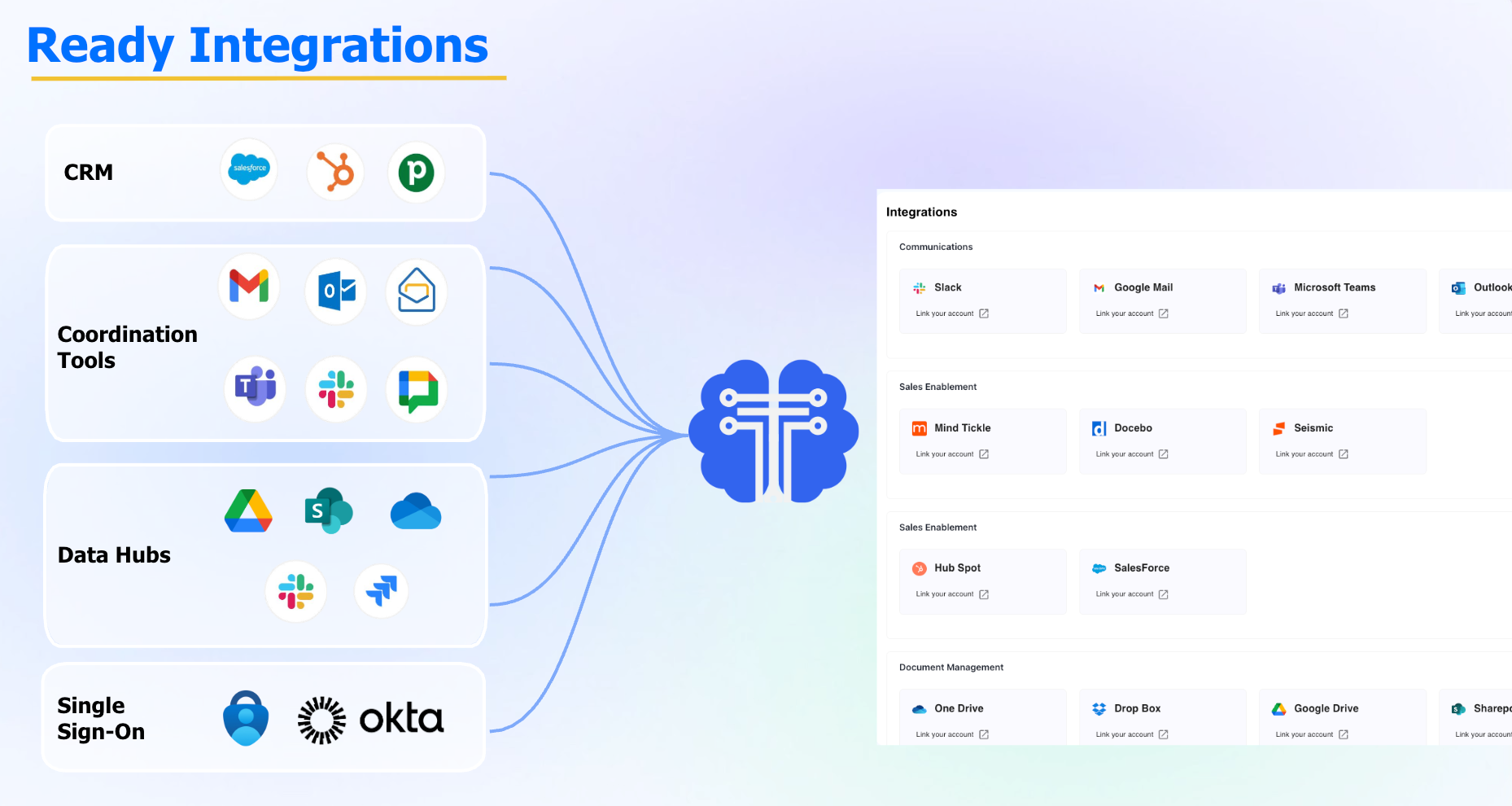
Evaluating RFP Response Tools
RFP Automation: Benefits and Misconceptions
RFP automation software has transformed how modern proposal teams, procurement professionals, and sales leaders approach the response process. By automating repetitive tasks like filling in compliance matrices, managing document formatting, and retrieving approved responses, teams can focus on strategic, high-impact work. The result is faster turnaround times, fewer errors, and more complete, compliant proposals.
Still, some myths persist. A common misconception is that automation removes human oversight or dilutes quality. In reality, platforms like Thalamus AI integrate human on the loop powered collaborative workflows, review checkpoints, and proposal approval flows that keep humans in the loop. With real-time collaboration via Google Workspace, Slack, and Outlook, teams maintain control while scaling accuracy. This blend of automation and expert review ensures high-quality responses without sacrificing compliance or personalization.
Practical Tips for Maximizing Your RFP Responses
1. Move Beyond Static Q&A Pair Libraries – Embrace AI-Powered Content Hubs
Modern content management systems like Thalamus AI offer dynamic, centralized content libraries that intelligently surface approved, compliant content - no need to manage thousands of answer pairs.. This eliminates the need to rewrite the same answers across hundreds of RFPs and ensures accurate answers based on enterprise standards, brand voice, and technical correctness.
2. Automate High-Effort Tasks
Leverage RFP automation software with advanced features like document shredding, auto-tagging requirements, and pre-filling answers using enterprise knowledge. This reduces manual effort in drafting responses to RFPs, RFIs, Security Questionnaires, and Due Diligence forms, helping proposal professionals save hours per submission.
3. Integrate with Your Collaboration Stack
Look for platforms with seamless integration capabilities across tools like Salesforce, Slack, and Microsoft Teams. Real-time feedback and task routing across departments reduce bottlenecks and enable cross-functional collaboration - critical for fast-moving deals and compliance-heavy responses.
4. Monitor Performance with Built-In Analytics
Top platforms now include insights into proposal performance, allowing teams to track turnaround times, response effectiveness, reviewer inputs, and win/loss outcomes. With advanced analytics dashboards, proposal managers and business development leaders can refine strategies over time.
Final Thoughts: RFP Software That Works With You, Not Just For You
If you’re evaluating RFP response tools in 2025, here’s what truly sets the next generation apart:
1. A Smart Content Library - No More Manual Q&A Maintenance
Forget outdated systems that rely on static Q&A pairs. Platforms like Thalamus AI offer an AI-powered content hub that dynamically surfaces relevant, pre-approved content without the overhead of manual upkeep. This ensures proposal teams spend less time hunting for the “right” response and more time refining win-worthy messaging.
2. AI Agents That Learn Your Narrative Over Time
Thalamus AI goes beyond templated responses. Its Agentic AI learns from your past wins, internal feedback, and team preferences, delivering more personalized, compliant, and persuasive answers with every submission. The more you use it, the smarter (and more accurate) it gets.
Beyond these core innovations, make sure your RFP software also delivers on the following must-have capabilities:
- Intelligent content reuse across sales documents and security-approved information
- Advanced document analysis software for parsing complex workflows
- Real-time collaboration tools with granular user roles
- Automated workflows and bid decision insights driven by usage analytics
- Scalable support for enterprise clients and unlimited users
Thalamus AI stands apart by combining all of the above with its Agentic AI architecture - a network of 20+ smart agents purpose-built for each step of the proposal creation process. From RFP intake to first winnable draft (in under 5 minutes), Thalamus empowers teams to generate accurate, high-quality, and compliant proposals at scale.
Whether you're handling 300-question security assessments, vendor due diligence, or government procurement RFPs, Thalamus transforms your entire procurement process from a manual grind to an intelligent, streamlined engine of growth.
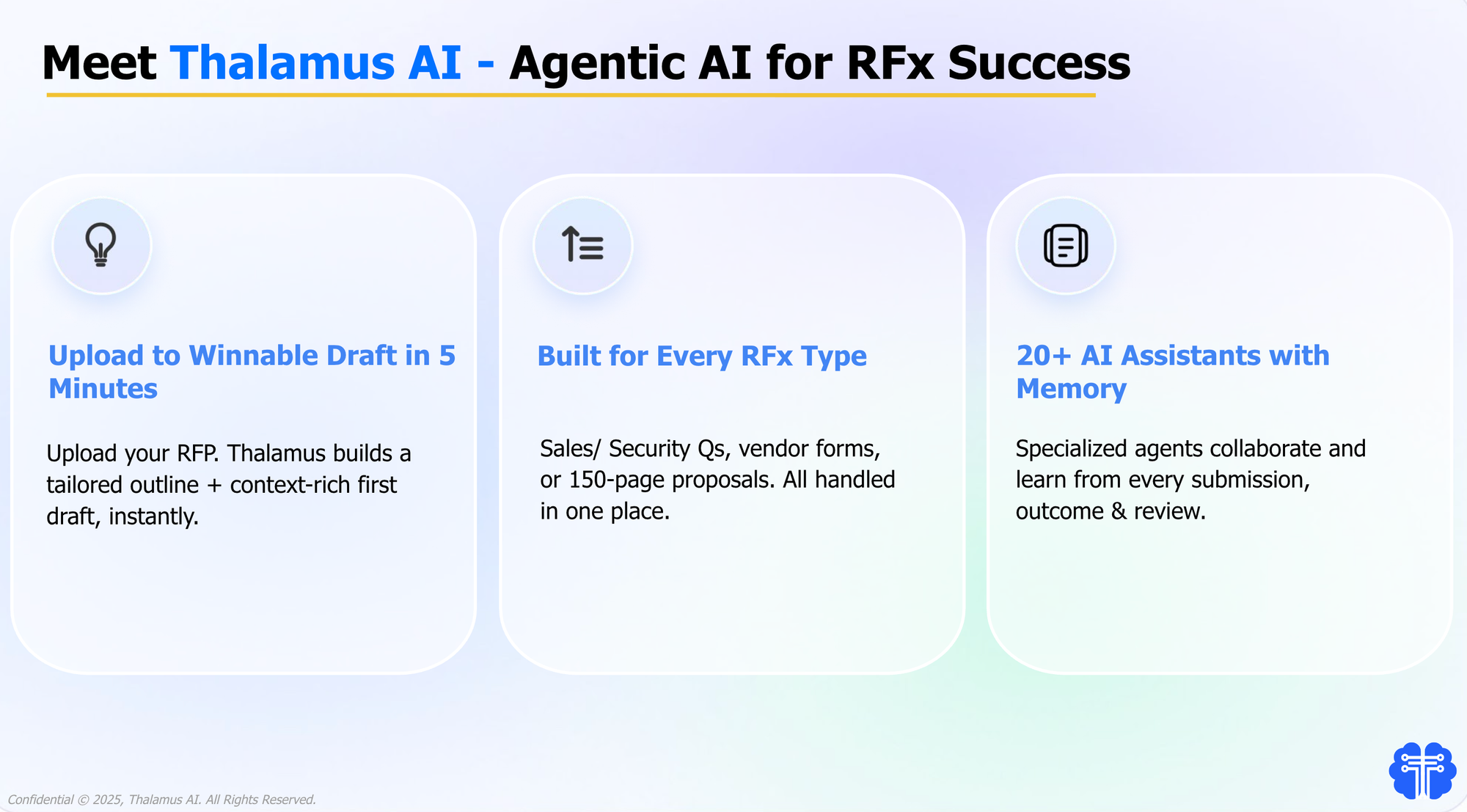
Ready to see it in action?
Schedule a demo today.
Explore Further:
- Want to know what’s next in proposal management? Read the 12 RFP Trends Shaping Proposal Management in 2026.
- Top 3 RFP Response Tools compared in detail here
- Rise of AI Agents in RFP Response Process?
- Thalamus AI Blogs
- 7 RFP ChatGPT Prompts That Win More Bids (Faster).
- Read our Top 3 AI Proposal Software in 2026 comparison to see which platform leads in automation, multilingual proposals, and win-rate performance.
Questions
- What is RFP software?
RFP software is a specialized proposal management tool that automates the response process for Requests for Proposals, Security Questionnaires, and Due Diligence forms. These tools help proposal teams streamline workflows, manage compliance, and accelerate response creation. Modern platforms like Thalamus AI go a step further with Agentic AI, enabling intelligent content reuse and rapid generation of high-quality, compliant proposals. - What is Thalamus AI?
Thalamus AI is an Agentic AI Proposal & RFP Software built for enterprises to streamline response management across RFPs, security questionnaires, vendor forms, and complex proposals.
Powered by 20+ smart AI agents, Thalamus shreds Requests for Proposal (RFPs), tags requirements, and generates winnable first drafts in under 5 minutes, helping proposal teams respond 5x faster and win 2x more. By leveraging boilerplate content, past proposals, project data, and case studies, it delivers 95% accurate, client-tailored responses that reflect your organization’s unique voice and expertise. - How does AI enhance the functionality of RFP software?
AI transforms traditional proposal software by automating repetitive tasks, drafting context-aware responses, and learning from past submissions to improve future outputs. Thalamus AI leads this evolution with 20+ specialized AI agents and a smart content library that delivers personalized, brand-aligned responses with 95%+ accuracy. - How can RFP software help manage large volumes of proposals?
RFP software simplifies high-volume response management by organizing tasks, automating response flows, and enabling real-time collaboration. Thalamus AI excels at handling hundreds of answers per project using document shredding, auto-tagging, and agent-led task routing - ideal for procurement professionals, proposal teams, and compliance-heavy industries. - How can I ensure successful onboarding of RFP software?
Look for tools that offer intuitive UX, smart integrations, and minimal end-user training. Thalamus AI is built with onboarding in mind, offering guided setup, native integrations with tools like Google Drive, Slack, and Salesforce, and contextual in-app prompts that reduce time-to-adoption for teams of any size. - What is the typical implementation time for RFP software?
Implementation times vary by platform, but modern tools like Thalamus AI are designed for fast deployment - typically within a few days to a couple of weeks. With plug-and-play integrations and zero heavy IT lift, you can be up and running quickly without disrupting your existing workflows. - Can the RFP software be accessed remotely?
Yes. Most RFP tools today are cloud-based platforms. Thalamus AI offers a fully remote-friendly experience - enabling proposal managers, subject matter experts, and sales teams to collaborate securely from anywhere via browser or mobile device. - What sets a next-generation RFP management platform apart?
Next-gen platforms go beyond static Q&A libraries and basic automation. Thalamus AI stands out with AI-powered proposal generation, dynamic content surfacing, advanced analytics, and agent-led collaboration. It’s not just faster - it’s smarter, more accurate, and purpose-built for modern proposal teams. - What is RFP automation and why does it matter?
RFP automation is the use of technology to streamline and accelerate the entire response process - from content intake and answer generation to compliance review and submission. Thalamus AI offers true RFP automation through its Agentic AI framework, empowering teams to reduce cycle times, eliminate manual errors, and win more deals with less effort.
